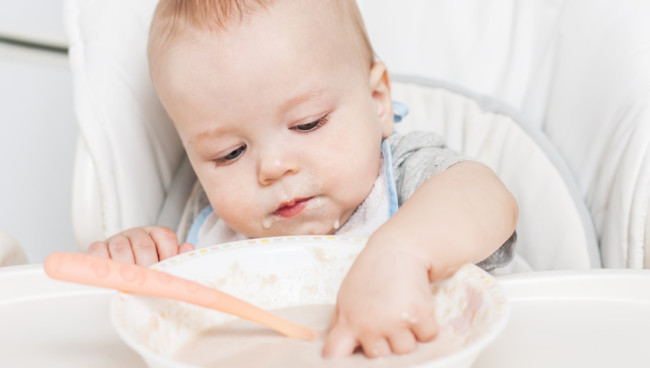This term quite frankly has lost its original meaning, let me explain…
The word “wean” in the British language means “adding a complementary food”, however, in the USA “weaning” means giving up breastfeeding.
Baby-led weaning (BLW) actually means following your baby’s lead, but over the years it has become a term for babies to self-feed. I am not quite sure how this happened, but it did and it appears that by ditching the purées and allowing your baby to self-feed, you are now a “BLW mom”!
The thing is, many parents actually follow BLW without even realising it, especially if it’s your second baby. Signs that your baby is ready to begin solid foods include; reaching out for food, showing huge interest and “mimicking” their parents or siblings.
It is during the “weaning window” that your baby will show these signs and by six months they will have developed enough to do this, which is just following baby’s lead and starting the weaning process at the right time.
All the rules still apply when introducing new foods; it’s just the way in which you offer it that differs.
What are the advantages of BLW?
Allowing your baby to self-feed gives them the opportunity to explore on their own, meaning it will enable them to cope with different food textures right from the beginning.
In our weaning workshops we explain this by offering our moms something new, some kind of food that they have never heard of and we put a spoon of it to their mouths. Every single one of our moms put their hands up in rejection, now the question we ask is why should you expect your baby to have a different attitude?
The first thing we need to do to accept this new food is to explore it with our five senses:
- Sight: What does it look like?
- Texture: How does it feel? Is it slimy, soft or hard?
- Smell: Does it smell sweet or does it smell savoury?
- Hear: Does it have a sound when it breaks?
- Taste: The final test.
By allowing your baby to self-feed, they are exploring and “feeding their senses”, which in turn encourages babies to choose healthier foods.
What are the disadvantages of BLW?
Okay BLW moms, it’s time to admit it, the whole process is extremely messy and there is a lot of waste as most of the time the food ends up on the floor. More importantly though, this method can limit your baby’s nutritional intake.
For some babies, finger foods can be hard to chew on such as meat, which is an excellent source of iron, a vital nutritional need.
The official advice is to give your baby well-mashed or puréed foods at the beginning of weaning, as well as finger foods. The Department of Health, the European Union, and the World Health Organisation all recommend this. Dieticians also tend to think it’s important to give your baby a variety of textures, which includes puréed foods as well as finger foods.
Are there any reasons why I shouldn’t try BLW?
If any of these points below apply to you, we would suggest you speak to your GP, trusted health practitioner or, you can contact us directly.
- A family history of allergies
- Digestive problems
- Possible food intolerances
- Does your baby have special needs, struggle with chewing or have difficulty picking up food and moving it towards his or her mouth?
- Was your baby was born prematurely?
Bumbles philosophy believes in both methods, there is no right or wrong way; we are here to support you and guide you. We love purées and love self-feeding, we love mess, we love exploring and we love baby to “feed their senses”.
Bumbles Cookery Club
Our goal is to guide and assist moms, and dads, through the different weaning stages and to understand and learn the importance of each stage, when to introduce each food group and how to create delicious, nutritionally balanced meals not only for your little one but for the whole family.
Latest posts by Bumbles Cookery Club (see all)
- What is baby-led weaning (BLW)? - August 22, 2014
- What foods should you choose for your baby? - August 21, 2014
- Real life: Working through my toddler’s intolerance to certain foods - August 20, 2014
-
No Comments" href="https://all4baby.co.za/pregnancy/planning-for-baby/1839/baby-changes-marriage-life/">

How having a baby changes your marriage and life
-
No Comments" href="https://all4baby.co.za/newborns-0-6-months/1819/together-mothers/">

Together, we are mothers
-
No Comments" href="https://all4baby.co.za/pregnancy/1804/dear-pregnant-women-everywhere/">

Dear pregnant women everywhere
-
No Comments" href="https://all4baby.co.za/babies-6-12-months/health-hygiene-illness/1802/spot-prevent-food-allergies-babies/">

How to spot and prevent food allergies in babies


 Saving...
Saving...